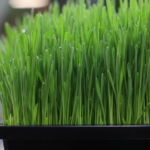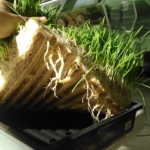
Three weeks at the Biosphere 2, and the barley growth experiment is nearly complete. The biomass accumulation plateaued a few days prior with overall CO2 production beginning to fall.
Overall, the experiment went very well. The data harvested is solid, from start to finish. While at moments there were what felt like major hurdles to the desired steady-state environment surrounding the experiment, one comes to realize that with 15,000 to 70,000 data points (depending upon the instrument) over 12 days, a half hour of direct sunlight on a grow chamber, or a 15 minute power loss to the fans and subsequent CO2 build-up has no affect on an overall trend.
 With three CO2 sensors, one at the outlet of each grow chamber and a third at the inlet to both chambers (as they are situated perpendicular to each other, sharing inlet air space, we found the daily fluctuations to match that of known CO2 correlations to temperature.
With three CO2 sensors, one at the outlet of each grow chamber and a third at the inlet to both chambers (as they are situated perpendicular to each other, sharing inlet air space, we found the daily fluctuations to match that of known CO2 correlations to temperature.
The data shows solid trends in all five of the parameters captured. While we came into the experiment principally interested in CO2, hoping to capture the photosynthetic draw-down of CO2 once the barley chlorophyll was activated, we learned that our seedbed was too thick, the underlying seeds remaining in a O2/CO2 respiration phase that kept the CO2 in the chambers higher than anticipated. Yet for the 30 minutes each day of direct sunlight (due to a gap in the shade cast by the LEO structure), we did see drastic reduction of CO2 in the data. We had considered full sunlight in this experiment, to invoke a higher CO2 draw-down, but knew it would be difficult to model the real-world weather (full sun, partial or full cloud cover, even a snow storm as occurred). What’s more, in a lunar or martian habitat, it is anticipated that all greenhouses will be located in lava tubes or buried beneath regolith to provide radiation protection for both the plants and humans that tend to them.
 While we had originally been concerned for of our ability to capture the increase in biomass (plant structure + water retained), in fact, we were quite successful. The digital scales with 0.1g sensitivity proved more than ample to provide this data. In fact, through the careful reduction of the data we are able to discern the amount of water lost to evaporation and plant respiration (combined). Now, we are drying the total, final plant biomass (over 5Kg, having started with just 800g) to learn how much was water retained and how much was true plant structure built from carbon intake, as no nutrients were added at any point in time.
While we had originally been concerned for of our ability to capture the increase in biomass (plant structure + water retained), in fact, we were quite successful. The digital scales with 0.1g sensitivity proved more than ample to provide this data. In fact, through the careful reduction of the data we are able to discern the amount of water lost to evaporation and plant respiration (combined). Now, we are drying the total, final plant biomass (over 5Kg, having started with just 800g) to learn how much was water retained and how much was true plant structure built from carbon intake, as no nutrients were added at any point in time.
As often happens with scientific experiments, we learn something different than the anticipated outcome, and know better how to conduct the experiment the next time through.

